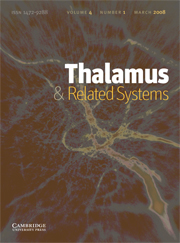Article contents
Axonal collateralization in primate basal ganglia and related thalamic nuclei
Published online by Cambridge University Press: 18 April 2006
Abstract
This paper provides an overview of the major organizational features of the basal ganglia and related thalamic centers, as delineated by the application of single-axon or single-cell labeling procedures in primates. These studies have revealed that the striatum, the external pallidum and the subthalamic nucleus harbor several types of projection neurons endowed with a highly collateralized axon that allows these neurons to interact with most components of the basal ganglia. In contrast, the internal pallidum, which is a major output structure of the basal ganglia, contains only two types of projection neurons. First, there is a minority of “limbic” pallidal neurons with a poorly branched axon that arborized profusely within the lateral habenula, which stands out as the most densely innervated pallidal target. Second, there is a majority of pallidal “motor” neurons with a long (total axonal length up to 27 cm) and highly branched axon that provides collaterals to the ventral tiers thalamic nuclei, the brainstem pedunculopontine nucleus and the centre médian/parafascicular thalamic complex. This type of axon allows internal pallidal neurons to send efferent copies of the same information to the thalamus and brainstem and hence influence various neuronal systems scattered throughout the neuraxis. Pallidal information is conveyed to the cerebral cortex and the striatum via the thalamus, while it is projected back to different components of the basal ganglia via the numerous reentrant pathways that arise from the pedunculopontine nucleus. Virtually all neurons in the centre médian thalamic nucleus innervate massively the striatum and less prominently the primary motor cortex, which in turn projects to the striatum directly or via a collateral from long-range corticofugal pyramidal axons. The results call for a reappraisal of our current concept of the anatomical and functional organization of basal ganglia, which play a crucial role in sensorimotor integration. Our data indicate that basal ganglia and related thalamic nuclei form a widely distributed neuronal network, whose elements are endowed with a highly patterned set of axon collaterals. This morphological feature allows a complex and exquisitely precise interaction between the various basal ganglia and related thalamic nuclei. The elucidation of this finely tuned network is needed to understand the complex spatiotemporal sequence of neural events that ensures the flow of cortical information through the basal ganglia and thalamus.
Keywords
Information
- Type
- Research Article
- Information
- Copyright
- 2002 Elsevier Science Ltd
- 7
- Cited by

